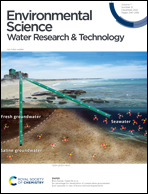Labile carbon release from oxic–anoxic cycling in woodchip bioreactors enhances nitrate removal without increasing nitrous oxide accumulation†
Abstract
Denitrification in woodchip bioreactors (WBRs) treating agricultural drainage and runoff is frequently carbon-limited due to the recalcitrance of carbon (C) in lignocellulosic woodchip biomass. Recent research has shown that redox fluctuations, achieved through periodic draining and re-flooding of WBRs, can increase nitrate removal rates by enhancing the release of labile C during oxic periods. While dying–rewetting (DRW) cycles appear to hold great promise for improving the performance of denitrifying WBRs, redox fluctuations in nitrogen-rich environments are commonly associated with enhanced emissions of the greenhouse gas nitrous oxide (N2O) due to inhibition of N2O reduction in microaerophilic conditions. Here, we evaluate the effects of oxic–anoxic cycling associated with DRW on the quantity and quality of C mobilized from woodchips, nitrate removal rates, and N2O accumulation in a complementary set of flow-through and batch laboratory bioreactors at 20 °C. Redox fluctuations significantly increased nitrate removal rates from 4.8–7.2 g N m−3 d−1 in a continuously saturated (CS) reactor to 9.8–11.2 g N m−3 d−1 24 h after a reactor is drained and re-saturated. Results support the theory that DRW conditions lead to faster NO3− removal rates by increasing mobilization of labile organic C from woodchips, with lower aromaticity in the dissolved C pool of oxic–anoxic reactors highlighting the importance of lignin breakdown to overall carbon release. There was no evidence for greater N2O accumulation, measured as N2O product yields, in the DRW reactors compared to continuously saturated reactors. We propose that greater organic C availability for N2O reducers following oxic periods outweighs the effect of microaerophilic inhibition of N2O reduction in controlling N2O dynamics. Implications of these findings for optimizing DRW cycling to enhance nitrate removal rates in denitrifying WBRs are discussed.



 Please wait while we load your content...
Please wait while we load your content...